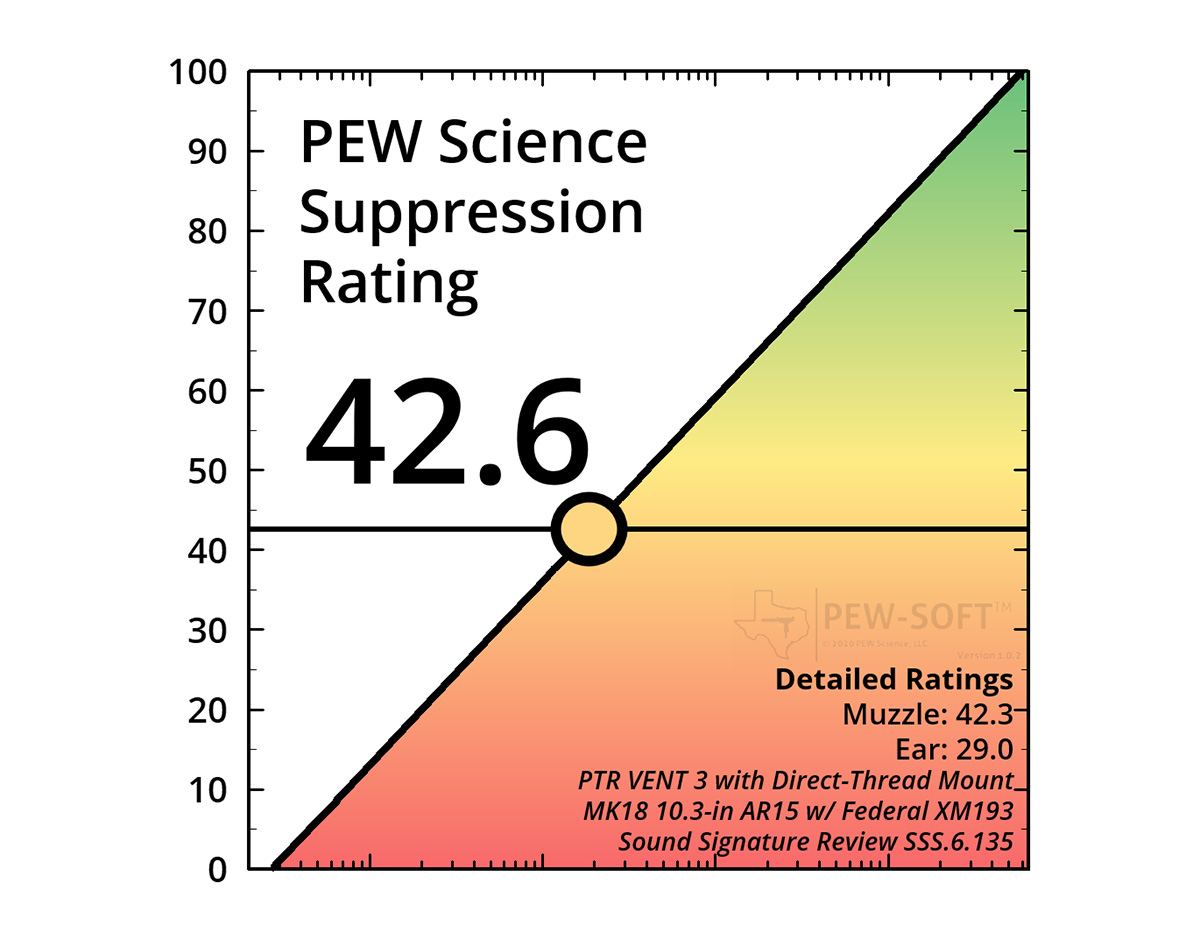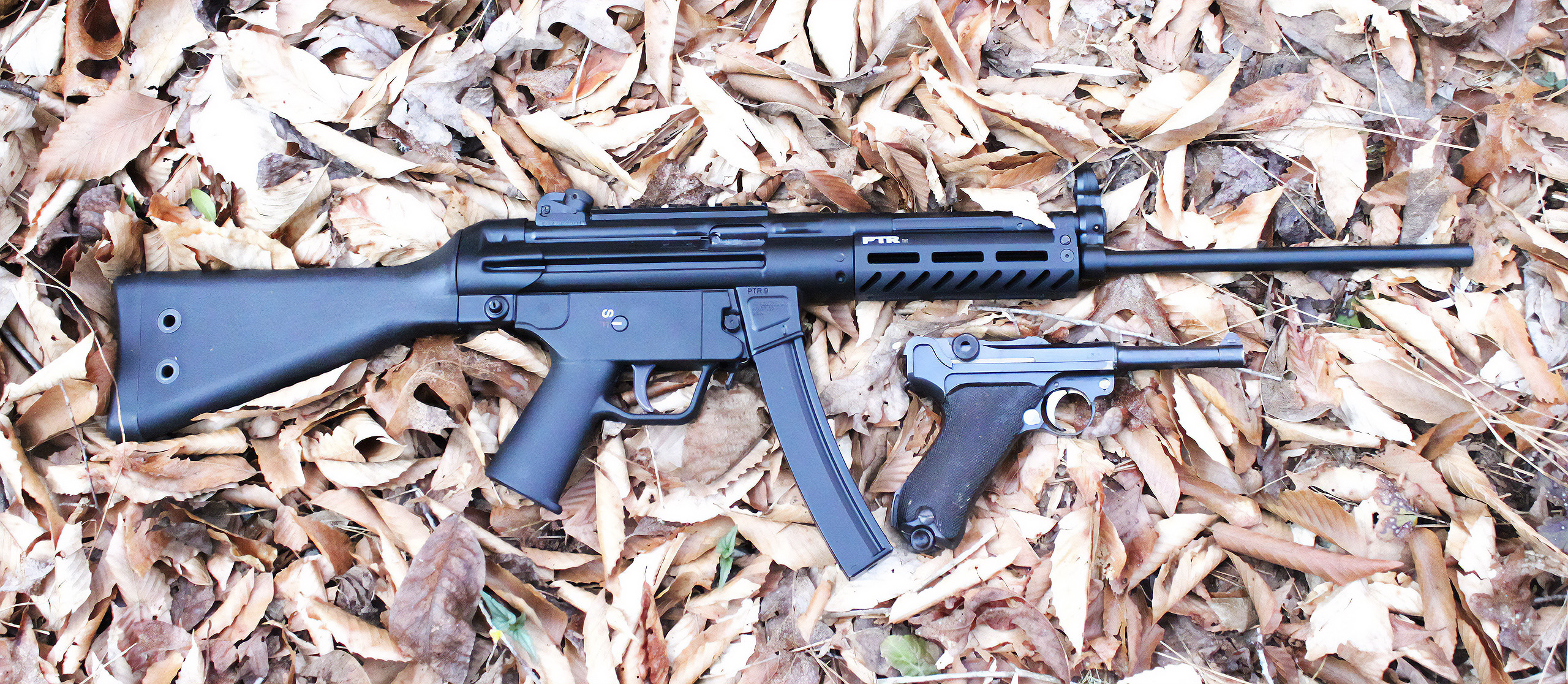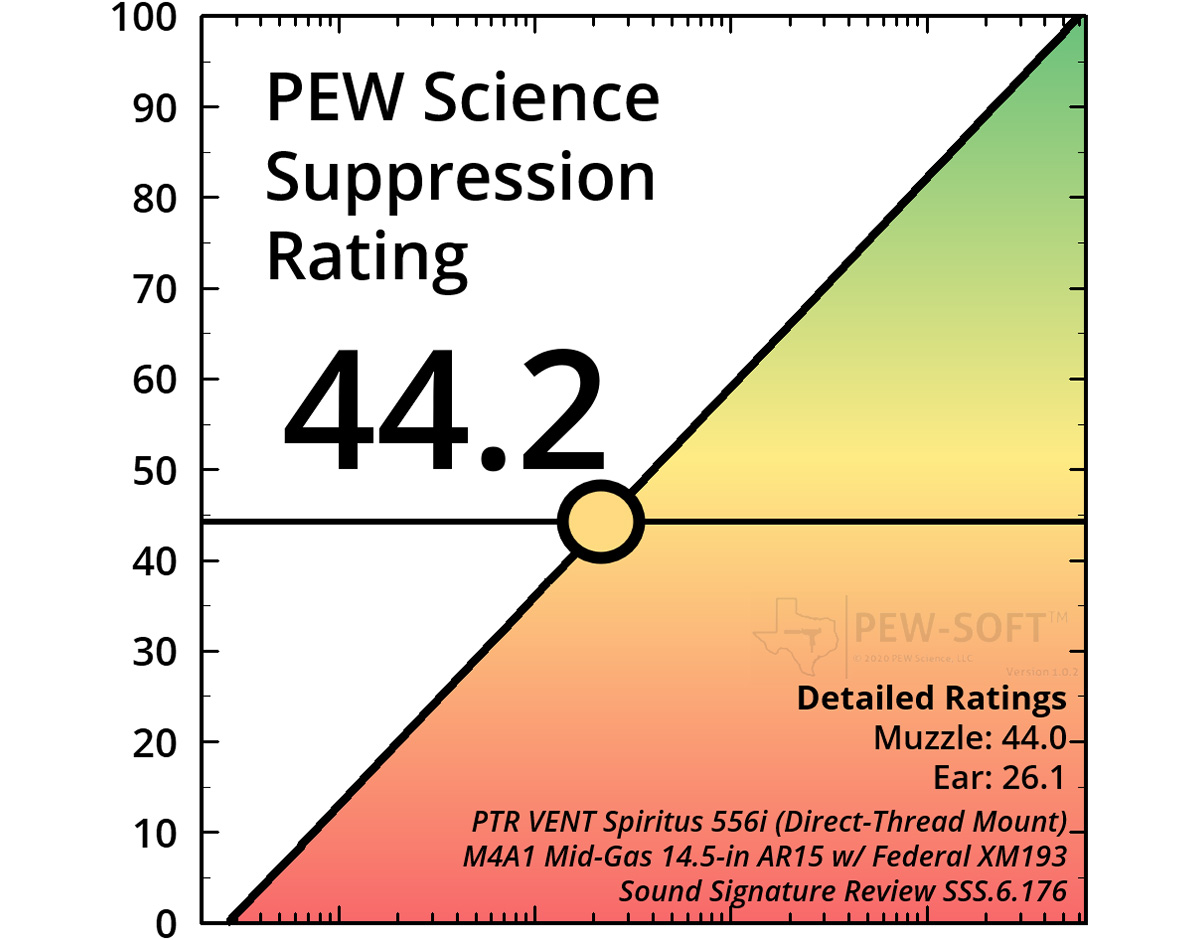The VENT 3 is designed and manufactured by PTR Industries. It is a 223 caliber centerfire rifle silencer, intended to suppress the 5.56x45mm cartridge on barrels 10.3 inches and longer, with semiautomatic or fully automatic fire. The VENT 3 has a 1.6-inch diameter and is 7.7 inches long. The silencer may be attached to a variety of weapon systems depending on the user’s choice of mount; the included 1/2-28tpi direct thread mount increases the system length to 8.1 inches. Other mounting options are possible due to the rear of the silencer body being HUB compatible (1.375”-24 tpi threading). The entirety of the VENT 3 structure is monolithic and constructed from 3D Printed Titanium. The silencer weighs 11.7 ounces and the included direct thread mount weighs 2.2 ounces, for a total system weight of 14 ounces, as tested. The VENT 3 can be obtained from PTR Dealers.
PEW Science is an independent private testing laboratory and also the world’s only publicly funded suppressed small arms research cooperative. Testing, data analysis, and reporting is generated with funding provided by PEW Science members. Any test data that is generated with any portion of private funding contains this disclosure. The testing and data production for this Sound Signature Review was funded in part by PEW Science Project PEW-PTR-070-001-23. Therefore, data pertaining to the VENT 3 in this Sound Signature Review is published with the express written permission of PTR Industries Inc.
This Sound Signature Review contains single-test results using the VENT 3 mounted with the direct-thread mount on the MK18 Automatic AR15 rifle, chambered in 5.56x45mm NATO with a 10.3-inch barrel. Federal XM193 55gr ammunition was used in the test. The standard PEW Science MK18 test host weapon system is described in Public Research Supplement 6.51.
- Section 6.135.1 contains the VENT 3 test results and analysis.
- Section 6.135.2 contains Suppression Rating comparisons of the VENT 3 with dedicated 223 and 30 caliber silencers on the current market, including the SilencerCo Velos LBP, BOSS Guillotine, CAT WB, PWS BDE 556, CAT ODB, Aero Precision Lahar-30L, Lahar-30, HUXWRX FLOW 762 Ti, Maxim Defense DSX, Thunder Beast Dominus, KAC 5.56 QDC, CGS SCI-SIX, Dead Air Nomad-30, YHM Turbo T2, Dead Air Sandman-S, HUXWRX FLOW 556k, Energetic Armament ARX, KAC QDSS-NT4, Rugged Razor556, Otter Creek Labs Polonium and Polonium-K, Surefire SOCOM556-RC2, HUXWRX HX-QD 556 and HX-QD 556k, Q Trash Panda, CGS Helios QD, SilencerCo Saker 556, Rugged Razor762, and others.
- Section 6.135.3 contains an article summary and PEW Science laboratory staff opinions.
Summary: When paired with the 10.3-in barrel MK18 and fired with Federal XM193, the PTR VENT 3 mounted with the direct-thread mount achieved a composite Suppression Rating™ of 42.6 in PEW Science testing.
As with all weapon systems, the user is encouraged to examine both muzzle and ear Suppression Ratings.
Relative Suppression Rating Performance is Summarized in SSS.7 – PEW Science Rankings
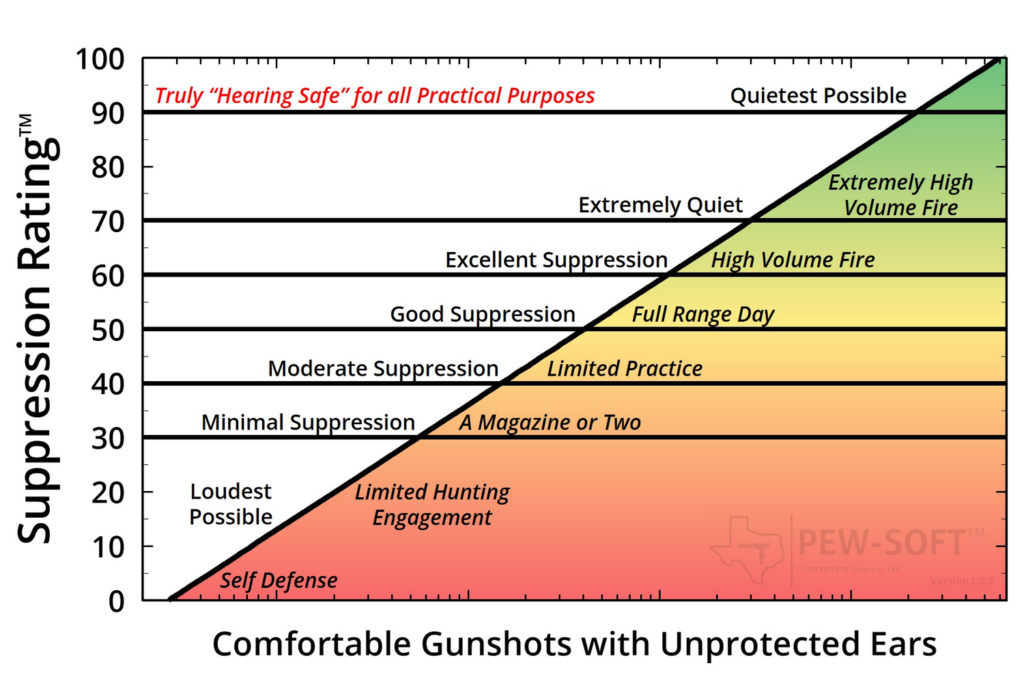
6.135.1 PTR VENT 3 Sound Signature Test Results
A summary of the principal Silencer Sound Standard performance metrics of the VENT 3 is shown in Table 1. The data acquired 1.0 m (39.4 in) left of the muzzle is available for viewing to all. The data acquired 0.15 m (6 in) right of the shooter’s ear is only available to membership supporters of PEW Science and the Silencer Sound Standard. You can support public PEW Science testing, research, and development with a membership, here. State-of-the-art public firearm sound signature testing and research conducted by PEW Science is supported by readers like you.
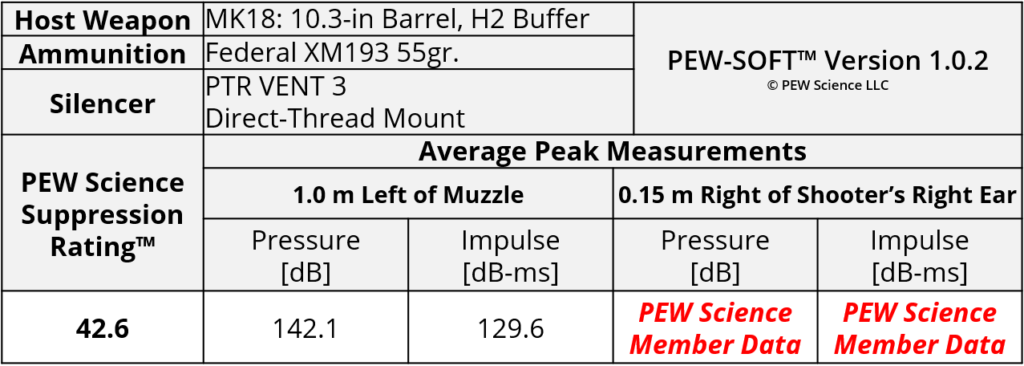
Table 1. PTR VENT 3 Sound Metric Summary
6.135.1.1 SOUND SIGNATURES AT THE MUZZLE
Real sound pressure histories from a 6-shot test acquired with PEW-SOFT™ are shown below. Six cartridges were loaded into the magazine, the fire control group positioned to single-shot, and the weapon was fired until the magazine was empty and the bolt locked back on the follower of the empty magazine. Only five shots are considered in the analysis. The signatures of Shot 6 are displayed in the data presentation but are not included in the analysis to maintain consistency with the overall PEW Science public dataset and bolt-closing signatures. The waveforms are not averaged, decimated, or filtered. The data acquisition rate used in all PEW Science laboratory sound signature testing is 1.0 MS/s (1 MHz). The peaks, shape, and time phasing (when the peaks occur in relation to absolute time and to each other) of these raw waveforms are the most accurate of any firearm silencer testing publicly available. PEW-SOFT data is acquired by PEW Science independent laboratory testing; the recognized industry leader in silencer sound research. For more information, please consult the Silencer Sound Standard.
The primary sound signature pressure histories for all 6 shots with the VENT 3 are shown in Figure 1a. The sound signatures of Shot 1 and Shot 2 are shown in Figure 1b, in early time. The real sound impulse (momentum transfer potential) histories from the same 6-shot test are shown in Figure 2a. In Figure 2b, a shorter timescale is shown comparing the impulse of Shot 1 to that of Shot 2 and Shot 3.

Fig 1a. PTR VENT 3 5.56x45mm NATO MK18 Automatic Rifle Muzzle Sound Pressure Signature

Figure 2a. PTR VENT 3 5.56x45mm NATO MK18 Automatic Rifle Muzzle Sound Impulse Signature

Fig 1b. PTR VENT 3 5.56x45mm NATO MK18 Automatic Rifle Sound Pressure Signature

Figure 2b. PTR VENT 3 5.56x45mm NATO MK18 Automatic Rifle Muzzle Sound Impulse Signature
The PTR VENT 3 is highly advanced and relatively lightweight. All silencers in the VENT series are hybrid designs. The VENT 3, like its somewhat smaller 9 mm sibling the VENT 2 (6.131), possess elements of both conventional silencer geometry, as well as high flow rate characteristics, that result in significant performance gains on semiautomatic host weapons. For an overview of the three primary classes of rifle silencer designs, the reader is encouraged to review PEW Science Research Supplement 6.124.
Like the previously examined SilencerCo Velos LBP (6.134), the VENT 3 contains design elements that are combined such that minimization of early-time internal blast impulse accumulation is realized, without regard to the degree to which external gas momentum accumulation occurs. The minimization of blast chamber impulse accumulation (alpha parameter) without regard to the minimization of the PEW Science Omega Metric research parameter (detailed in public Research Supplement 6.40), enables a silencer design to provide both favorable weapon kinematics and more favorable sound field even near reflecting surfaces. However, unlike in the Velos LBP, the VENT series’ distal venting is not direct; gasses are first forced through a porous material lattice structure. This significantly increases performance; the late time flow restriction results in a free field signature with gas momentum characteristics closer to that of a CAT ODB (6.120) or CAT WB (6.129) on this weapon system. In contrast to those two CAT silencers, however, the PTR VENT 3 suppresses pressure amplitude more significantly through both greater turbulence and heat transfer. Even though the CAT silencers have a higher degree of impulse attenuation, in this particular zone of combustion amplitude and duration, the PTR silencer provides superior free field hazard reduction. Though the PTR silencer is larger, its performance is still extremely notable.
PEW Science Research Note 1: The PTR VENT 3, like other silencers in the VENT series, contains the PTR Purposely Induced Porosity (PIP) technology, along with other staged flow geometry, to significantly increase both early-time and gross flow rates. Notably, the technology also possesses significant sound suppression performance potential with both subsonic and supersonic ammunition. There are several features of note in the above measured signatures demonstrating high suppression performance on this platform:
- The gross free field pressure amplitudes are significantly suppressed (Fig 1a.) and decay expediently in early time.
- Precursor flow, bullet shock, and primary jetting occur steadily and consistently, from shot to shot. The gas momentum accumulation is highly uniform (Fig 2a).
The longer path lengths, and specifically the longer duration of gas flow contact with its lattice structures in combination with its stepped conventional baffle geometries, enable the VENT 3 to produce extremely high suppression performance. The PTR VENT 3 achieves a 42.6 Suppression Rating at the muzzle, which is unprecedented for its size, in PEW Science testing. Furthermore, the VENT 3 achieves this with a combined 29.0 Suppression Rating at the shooter’s ear, which demonstrates a significant reduction in operator hazard on the MK18 weapon system. The combination of these two performance traits, on the standard MK18, is also unprecedented in PEW Science testing. Furthermore, demonstrating this efficacy in multiple combustion regimes shows that the PTR PIP technology continues to represent one of the most significant advancements in the suppressed small arms state of practice.
PEW Science Research Note 2: The duration of turbulence generation and heat transfer achieved in the time regime of annular venting is paramount to maximizing muzzle blast suppression in high flow rate designs. Allowing this blast load gradient to maintain a minimum forward velocity without significant stagnation, or alternatively preventing secondary stagnation through staged venting, appears to demonstrate the highest degree of efficacy shown in the Silencer Sound Standard research pedigree, to date. Of the high flow rate rifle silencer system designs evaluated, PIP, SURGE BYPASS, and Flow-Through show the highest performance potentials. Note that only the former two technologies are hybrid designs. Blast load reflection factor phenomena suggest that hybrid designs stand the best chance of reducing hazard outside of the free field, near reflecting surfaces. Research in the regime of the load shapes and amplitudes of blast loads produced by suppressed small arms is ongoing.
Previously presented high level summaries of high flow rate designs are repeated below, for reference:
- Rifle silencers with CGS Hyperion Technology (Hyperion, Hyperion K, and the Helios QD) – early-time venting to annular space with or without direct distal venting.
- OSS and HUXWRX Helix HX-QD and FLOW series Flow-Through rifle silencers – direct early-time venting to annular space with toroidal overlapping gas paths and direct distal vent arrays.
- Sig Sauer SLH series Forward Flux rifle silencers – direct annular porting and direct distal vent arrays.
- Liberty Precision Machine Torch – direct early-time venting with or without direct distal venting.
- CAT ODB and WB SURGE BYPASS rifle silencers – direct early-time venting to annular cavities with multiple stages and complex distal venting.
- PTR PIP silencers – direct early-time venting to annular lattice structures with distal venting through the same.
PEW Science Research Note 3: The first round pop (FRP) signature of the VENT 3 on this weapon system is shown to be noticeable to bystanders in the free field but not severe, in accordance with PEW Science analysis. After FRP, both the measured signatures, and the analyzed inner ear response of bystanders, is extremely consistent. The signature suppression consistency of the PTR VENT 3 silencer, on this weapon system, is among the highest measured by PEW Science, to date.
PEW Science Research Note 4: As in all semiautomatic AR15 weapon testing, a second pressure pulse originates from the ejection-port signature of the weapon and it occurs early enough in time such that its waves coalesce with that of the muzzle signature. However, in late time (at approximately 85 ms in Figure 1a) the mechanical noise of the bolt closing is observed. The pressure signature of Shot 6 does not display this event due to the bolt remaining open after the sixth and final round is fired from the magazine.
PEW Science Research Note 5: The closing time of the MK18 bolt is directly related to the flow restriction of a silencer for a given weapon system. PEW Science has determined bolt closing time variation from the unsuppressed state to be a reliable indicator of silencer back pressure, with strong correlation with the PEW Science Back Pressure Metric, Omega and the alpha parameter. However, PEW Science has also determined that the indicator is unreliable upon upper receiver fouling. Sound signatures are not influenced by this fouling, as these kinematics occur in late time, after gas venting to atmosphere. Momentum transfer, weapon condition (upper receiver fouling), and other factors, can significantly influence bolt closing time. PEW Science urges the reader to exercise extreme caution if using the published bolt closing time to make determinations regarding silencer flow restriction (back pressure) or weapon system kinematics. This type of calculation may provide erroneous results, as the weapon condition at the time of each test is not published data. The time-scale duration showing bolt closing time is only published by PEW Science such that the signature data pedigree may be verified. There are other signature features measured at the shooter’s ear which may further assist with quantifying weapon kinematics.
As typically indicated, first-round sound signatures always differ from subsequent shots, as the atmosphere within the silencer changes. The FRP phenomenon cannot always be shown by viewing only the peak sound pressure. This is one of the reasons why The Silencer Sound Standard requires examining multiple sound signature metrics. Ammunition consistency can play a role in the determination of FRP, however, the close examination of measured pressure and impulse waveforms typically excludes ammunition from the possible factors influencing true FRP, due to the relative consistency of most high quality factory ammunition.
PEW Science Research Note 6: Note that the muzzle Suppression Rating of the PTR VENT 3 is 42.3 and the at-ear Suppression Rating is 29.0; different zones on the Suppression Rating Dose Chart. Unlike many rifle silencers, the high early time flow rate of the PTR VENT 3 is beneficial to the sound signature at the shooter’s ear on the standard MK18 weapon system. The resulting back pressure of the VENT 3 is low, and the muzzle signature is suppressed adequately enough, that the weapon operator is subjected to less significant hearing damage risk.
6.135.2 Suppression Rating Comparison (5.56x45mm from the MK18)
Figure 6 presents a comparison of the PEW Science Suppression Rating of the PTR VENT 3 to that of other rifle silences on the MK18 automatic AR15 rifle. The standard PEW Science MK18 test host weapon system is described in Public Research Supplement 6.51.
PEW Science Laboratory Staff Opinion:
The PTR VENT 3 is a full size 5.56mm machine gun rated rifle silencer that exhibits significant sound suppression and back pressure reduction. It is lightweight, possesses adaptable mounting, and exhibits some of the highest signature suppression performance on the standard MK18 weapon system of any silencer evaluated by PEW Science, to date. The performance of the Purposely Induced Porosity (PIP) technology in the silencer, along with other portions of its design, is notable and represents further 3D-printed advancement in the suppressed small arms state of practice.
The PTR VENT 3, like other silencer in the VENT series, contains the PTR Purposely Induced Porosity (PIP) technology, along with other staged flow geometry, to significantly increase both early-time and gross flow rates. Notably, the technology also possesses significant sound suppression performance potential with both subsonic and supersonic ammunition. Its long path lengths, and specifically the longer duration of gas flow contact with its lattice structures in combination with its stepped conventional baffle geometries, enable the VENT 3 to produce extremely high suppression performance. The combination of muzzle and ear suppression, on the standard MK18 is unprecedented in PEW Science testing. Demonstrating this efficacy in multiple combustion regimes shows that the PTR PIP technology continues to represent one of the most significant advancements in the suppressed small arms state of practice.
The duration of turbulence generation and heat transfer achieved in the time regime of annular venting is paramount to maximizing muzzle blast suppression in high flow rate designs. Allowing this blast load gradient to maintain a minimum forward velocity without significant stagnation, or alternatively preventing secondary stagnation through staged venting, appears to demonstrate the highest degree of efficacy shown in the Silencer Sound Standard research pedigree, to date. Of the high flow rate rifle silencer system designs evaluated, PIP, SURGE BYPASS, and Flow-Through show the highest performance potentials. Note that only the former two technologies are hybrid designs. Blast load reflection factor phenomena suggest that hybrid designs stand the best chance of reducing hazard outside of the free field, near reflecting surfaces. Research in the regime of the load shapes and amplitudes of blast loads produced by suppressed small arms is ongoing.
The nearest competitor to the PTR VENT 3, in free field muzzle suppression, is the Maxim Defense DSX. The DSX achieves this suppression with significant flow restriction. It takes purposeful weapon tuning to combat its high back pressure, as evidenced in the testing of the Maxim Defense SURG system, in which the only variable was the effective gas port orifice size. The PTR VENT 3 is not only able to outperform restrictive silencers like the DSX at the muzzle, but approach their tuned level of hazard reduction at the shooter’s ear on this weapon system, with no tuning necessary. Again, this combination of muzzle and shooter’s ear suppression on an untuned MK18 is unprecedented in PEW Science testing. A similar comparison can be drawn between the PTR VENT 3 and other silencers with high muzzle suppression performance but significant flow restriction, which increases shooter hazard. The reader is encouraged to compare the holistic performance of the VENT 3 with the Aero Precision Lahar-30L, Otter Creek Labs Polonium, and PWS BDE 556. All three of those silencers possess high muzzle Suppression Ratings, but also result in significant blast overpressure out of the weapon ejection port, lowering the level of protection to the operator.
The included direct thread mount is easy to install in the VENT 3, and possesses hex-wrench features on the exterior. The mount may be removed and other mounts compatible with the so-called HUB threading system may be installed. This feature allows the VENT 3 to be used with a variety of weapon systems.
It is likely, given the venting geometry of the PTR VENT 3, that the silencer is relatively durable on automatic weapons, for a titanium silencer. Manufacturer guidance suggests a minimum 5.56x45mm barrel length of 10.3 inches and a maximum automatic firing schedule of 120 rounds, with 10 minute cooldown period intervals. The reader is encouraged to contact the manufacturer for guidance in accordance with their desired use case.
In this review, the PTR VENT 3 performance metrics depend upon suppressing a supersonic centerfire rifle cartridge on a short barrel gas-operated rifle, which is an incredibly difficult task. PEW Science encourages the reader to remain vigilant with regard to all supersonic centerfire rifle suppression claims. The gas volume and combustion products created by the firing of the supersonic 5.56x45mm cartridge are significant; the measured pressure and impulse magnitudes, and their durations, illustrate this fact. Silencer performance on automatic (reciprocating) rifles depends on many factors. Weapon configuration may significantly influence total suppressed small arm system performance.
The hearing damage potential of supersonic centerfire rifle use is significant. PEW Science encourages the reader to consider the Suppression Rating when deciding on an appropriate silencer and host weapon combination for their desired use.

